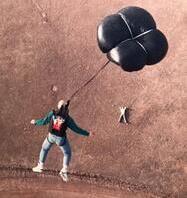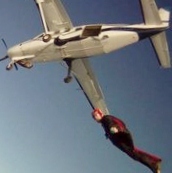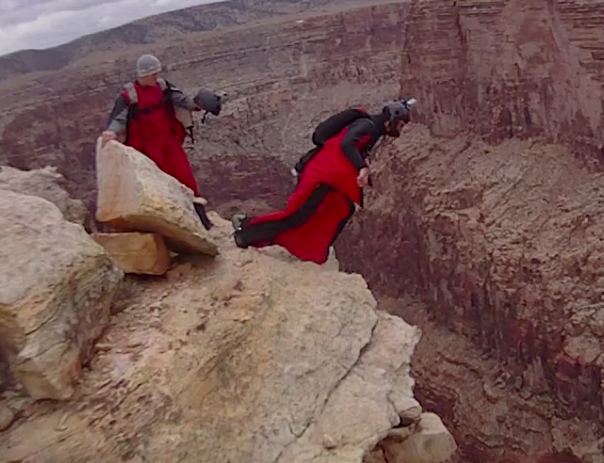Recommended Posts
base428 1
Not that I want to rehash this again, but I have some new information below....
More freefall is good. If you have a pilot chute error (like the last 5 fatalities in Twin Falls), then you have more time for it to be cleared. You also have more time to set up for landing.
I agree with you on this one, which is why I approached the Bridge Day Commission (BDC) to get approval to do PCA's from the catwalk level this year. I wanted all first timers to be PCA'd from the edge of the steel so there would be no chance of object strike if they PCA'd from the normal exit point on top of the bridge. The BDC didn't waste any time saying NO. I believe they are worried that catwalk access would give us an advantage in obtaining permission to jump beyond bridge day, but the official reason was overcrowding of the catwalk.
The main landing area is the RIVER. If you can't hit the RIVER, then you've got bigger problems. The smaller LZ that you speak of is quite easy for anyone with decent accuracy skills. I've seen the newest of newbies hit the LZ each time without any problems. I've even seen a round parachute land dry in the LZ (crazy Russian guy). But yes, it can be intimidating until you actually land there and water level is a factor.
Jumpers have plenty of time to get prepared for the jump and then get in line after a gear check when they're ready. We don't force anyone to jump within a certain time period. There is no stopwatch.
The BDC and NPS chose to disclude the BASE Jumping Coordinators (Bill Bird and I) in the release of both fatality reports so far. I received no questions or calls from the BDC/NPS relating to the fatality reports, nor have I ever officially received a copy of anything related to the fatality. I was not given the opportunity to review or provide comments prior to the "public" fatality report released earlier this week. The public fatality report is full of errors and assumptions. I've officially requested a REVISED fatality report from the BDC.
The main cause of Brian's fatality was his pilot chute deployment into his chest at the 5 second mark, where it became trapped for at least 2 seconds. I was able to review more video recently on a high def TV and this is the conclusion that I (and others) have come up with. Brian was able to extract his PC from his chest at 7 seconds and you can see a lot of right arm movement at this time. Hopefully the BDC will correct the fatality report based on this and other information I have submitted to them. Could Brian have had more recent experience? I don't know, because no one knows the date of his last parachute jump. We will check parachute currency this year, but I doubt it will affect but a handfull of jumpers.
There is much more information to mention, but I'm not that interested in posting to this forum lately. If you want to know more, email me. But I did want everyone to know the technical reason for Brian's fatality (PC deployed into his chest and trapped from 5-7 second mark).
QuoteActually more freefall is bad for newbies.
More freefall is good. If you have a pilot chute error (like the last 5 fatalities in Twin Falls), then you have more time for it to be cleared. You also have more time to set up for landing.
QuotePCA's or staticline jumps are not permitted at BD.
I agree with you on this one, which is why I approached the Bridge Day Commission (BDC) to get approval to do PCA's from the catwalk level this year. I wanted all first timers to be PCA'd from the edge of the steel so there would be no chance of object strike if they PCA'd from the normal exit point on top of the bridge. The BDC didn't waste any time saying NO. I believe they are worried that catwalk access would give us an advantage in obtaining permission to jump beyond bridge day, but the official reason was overcrowding of the catwalk.
QuoteThe landing area is retaredly small for newbies. Hell it's small for a Pro Rated skydiver.
The main landing area is the RIVER. If you can't hit the RIVER, then you've got bigger problems. The smaller LZ that you speak of is quite easy for anyone with decent accuracy skills. I've seen the newest of newbies hit the LZ each time without any problems. I've even seen a round parachute land dry in the LZ (crazy Russian guy). But yes, it can be intimidating until you actually land there and water level is a factor.
QuoteNothing good about putting a stopwatch on a jumper and making him/her feel the pressure to get off fast.
Jumpers have plenty of time to get prepared for the jump and then get in line after a gear check when they're ready. We don't force anyone to jump within a certain time period. There is no stopwatch.
The BDC and NPS chose to disclude the BASE Jumping Coordinators (Bill Bird and I) in the release of both fatality reports so far. I received no questions or calls from the BDC/NPS relating to the fatality reports, nor have I ever officially received a copy of anything related to the fatality. I was not given the opportunity to review or provide comments prior to the "public" fatality report released earlier this week. The public fatality report is full of errors and assumptions. I've officially requested a REVISED fatality report from the BDC.
The main cause of Brian's fatality was his pilot chute deployment into his chest at the 5 second mark, where it became trapped for at least 2 seconds. I was able to review more video recently on a high def TV and this is the conclusion that I (and others) have come up with. Brian was able to extract his PC from his chest at 7 seconds and you can see a lot of right arm movement at this time. Hopefully the BDC will correct the fatality report based on this and other information I have submitted to them. Could Brian have had more recent experience? I don't know, because no one knows the date of his last parachute jump. We will check parachute currency this year, but I doubt it will affect but a handfull of jumpers.
There is much more information to mention, but I'm not that interested in posting to this forum lately. If you want to know more, email me. But I did want everyone to know the technical reason for Brian's fatality (PC deployed into his chest and trapped from 5-7 second mark).
(c)2010 Vertical Visions. No unauthorized duplication permitted. <==For the media only
EPX 0
First I want to thank Mr. B. for making BD happen for everyone and hope he doesnt take all the crap people dish out on this to harshly... its easy to do the 20/20 hindsite on this...
Secondly, ten years ago, when i was still a n()()by, and only had 40 skydives, a very scary imposing tandem master assured me that i could BASE there with no problems, and i havent had any problems since...
However since then, with all the surging interest there obviously needs to be some minimum requirements, but to say they are more necessary than education is rediculous...
You take your life into your hands every time you jump, no one needs to be responsible for you besides you...I think we have enough a$$holes in the sport, we do not need to diminish the memory of someone who seemed to have been a positive influence
Secondly, ten years ago, when i was still a n()()by, and only had 40 skydives, a very scary imposing tandem master assured me that i could BASE there with no problems, and i havent had any problems since...
However since then, with all the surging interest there obviously needs to be some minimum requirements, but to say they are more necessary than education is rediculous...
You take your life into your hands every time you jump, no one needs to be responsible for you besides you...I think we have enough a$$holes in the sport, we do not need to diminish the memory of someone who seemed to have been a positive influence
you want me to do what???
QuoteThe main landing area is the RIVER.
The logic of that is
I sat through every minute of the briefings last year. THe river was always refered to as a safe out.
Boats or no boats, landing in the water adds another level of danger.
----------------------------------------------
You're not as good as you think you are. Seriously.
You're not as good as you think you are. Seriously.
base428 1
QuoteTHe river was always refered to as a safe out.
Our exact words each year include "the river is your primary landing area". The water rescue guy (long pony tail) told you this as well early during the Friday 7pm meeting.
Regardless of whether you heard us or not, the river is currently our primary LZ. We pay $2800 for four boats each year and they will usually be plucking you out of the river before you come up for your first breath of air.
And yes, we are each ultimately responsible for our own safety.
(c)2010 Vertical Visions. No unauthorized duplication permitted. <==For the media only
You take your life into your hands every time you jump, no one needs to be responsible for you besides you...I think we have enough a$$holes in the sport, we do not need to diminish the memory of someone who seemed to have been a positive influence
__________________________________________________
Thanks. The sport needs more guys like you.
__________________________________________________
Thanks. The sport needs more guys like you.
In theory, there is no difference bretween theory and practice. In practice, however, there is. -
"RIP Forever Brian Schubert. Always remembered, Never forgotten" - Leroy DB
http://www.johnny
"RIP Forever Brian Schubert. Always remembered, Never forgotten" - Leroy DB
http://www.johnny
base698 1
Quote
More freefall is good. If you have a pilot chute error (like the last 5 fatalities in Twin Falls), then you have more time for it to be cleared. You also have more time to set up for landing.
I think what JP was saying relates to what you see time and time again of an AFF level 1 on his back spinning or someone in the tunnel out of control. On a BASE jump is not the time to be with no or little freefall experience. If you get disoriented/out of control you die, period. It's better to take that out of the equation entirely and have them do a static line jump--that way at least they get a canopy over their head.
Bolas 5
I didn't even think about doing Bridge Day until I had done some helicopter and balloon jumps so I'd be familiar with dead air.
Stupidity if left untreated is self-correcting
If ya can't be good, look good, if that fails, make 'em laugh.
If ya can't be good, look good, if that fails, make 'em laugh.
jdatc 0
QuoteI didn't even think about doing Bridge Day until I had done some helicopter and balloon jumps so I'd be familiar with dead air.
And even then your 1st exit was...... headlow perhaps? But the dead air skills allowed you to recover....
I believe Balloon and helicopter jumps are good for the whole 'dead air experience', but most balloon and helicopter pilots don't like you to push off hard like a good solid base exit...
They prefer you to fall off, so as not to upset the aircraft.
At least with 'the standard pool' exit practice you get to push off hard...
So what do you opt for? Practice a good hard launch into a pool that isn't really a jump, or a helicopter / balloon jump with some dead air practice to right yourself?
I'd say the best case scenario is a mix of both, but since there are no guarantees in base, you could still mess up the exit...
However, if your exit goes well, things tend to stay in that direction... If you zoo your exit well, you may need those dead air skills pretty quick.... if and only if there is enough height for that....
just my thoughts-
_justin
Most bridges don't require you to push off hard. It would be good practice for future BASE jumps though.
mojo240 0
Safer at Twin Falls than Bridge Day???? How many fatalities at each place so far?
Ether 0
Four at NRG (#5, #13, #16, #103).
Five at TF (#63, #78, #99, #104, #111).
Keep in mind, however, that NRG is only jumped once a year (plus the occasional illegal jump), and TF is jumped year-round.
Five at TF (#63, #78, #99, #104, #111).
Keep in mind, however, that NRG is only jumped once a year (plus the occasional illegal jump), and TF is jumped year-round.
Looking for newbie rig, all components...
Ghetto 0
NRG has also been popular for far longer than TF... Notice that all 5 TF fatalities have happened since #63, yet the first 3 NRG fatalities were 15+ years ago, then followed by the only NRG fatality since 1987
Web Design
Cleveland Skydiving
"Hey, these cookies don't taste anything like girl scouts..."
Cleveland Skydiving
"Hey, these cookies don't taste anything like girl scouts..."




It's not so much the length of time between base jumps as the length of time since he had parachuted at all. Even with bad legs, a few water jumps from a plane would have been a good idea.
Bruce McConkey 'I thought we were gonna die, and I couldn't think of anyone
Share this post
Link to post
Share on other sites